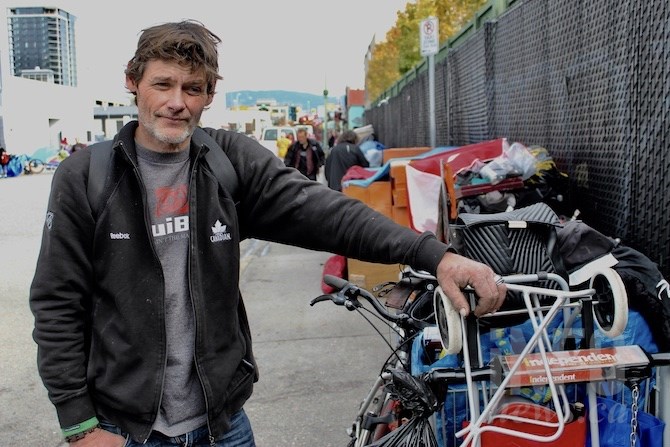
Dave Braun is a long-time Kelowna resident who is one of the growing number of homeless sleeping rough on Leon Avenue.
(ROB MUNRO / iNFOnews.ca)
October 03, 2019 - 9:00 AM
KELOWNA - The 200 block of Leon Avenue is looking more and more like a tent city as the growing number of homeless in downtown Kelowna only have the sidewalks to sleep on.
“The number of people who are sleeping rough in the downtown core has nearly doubled from an average of 22 in June to an average of 42 in September,” Darren Caul, Kelowna’s community safety director, told iNFOnews.ca yesterday, Oct. 2.
About half of those people are local while the other half may have come from elsewhere, estimates Adrienne B. who has been homeless, in and out of shelters and sleeping rough for the last six years.
“I can’t understand why they give us a place to stay and, someone has mental health problems and yells, so they get kicked out,” she said. “We’ve got no place to go.”
Caul said the city is taking a humanitarian approach as the weather gets colder and is allowing people to set up shelters along the street. The city rouses them three days a week to spray down the road and sidewalks then lets them set up again.
Dave Braun just recently moved to Leon after he says his camping gear was either stolen or confiscated by the city. He had been camping on vacant land south of the Eldorado Hotel.
He’s a long-time Kelowna resident who says he used drugs most of his life, even while he ran a flooring company for 30 years. But after an injury that put him in hospital and a break up a couple of years ago, he had no place to go.
“I overdosed so many times that (my wife) didn’t want me to stay around so she could watch me die,” he said. He’s still in occasional contact with his wife and children.
He estimates he’s overdosed more than 100 times, sometimes two or three times a day. He believes that he now has brain damage from those overdoses and needs housing where he can get support because he has trouble remembering things.
Still, he spends his nights foraging in garbage bins for food and clothing. Some of which he sells but much of it he gives away.
“I know some single moms who I take boxes of food to,” Braun said. “It makes me feel good.”
He has been kicked out of the Gospel Mission and Cornerstone emergency shelters. Once when he says he fell asleep on the floor and responded badly to being woken up. More recently, it was for smoking heroin on site.
He’s now on the Opioid Agonist Treatment program which provides opioid substitutes so he’s not risking his life taking street drugs and not waking up with a drug hangover every morning.
Adrienne, too, would like to get off drugs, talking about an $8,000 treatment program she would like to take. If the government can pay for housing, why can’t they also pay for treatment, she asked.
As a long-time Leon resident, she blames the increasing number of homeless on addictions and said crystal meth is a particularly evil drug, pointing to a woman wandering back and forth across the street, narrowly avoiding being hit by the few cars that travel that block.
“Six years ago, she was normal,” Adrienne said. Now the woman doesn’t have to be on drugs to be talking to herself and weaving dangerously in the middle of the street.
Jeff Babkowsky was hanging out with them but does not live on Leon, saying his stuff gets stolen.
Why is he on the street?
“Someone stole my rent money,” he said. That was five years ago. “I just gave up. I usually don’t give up, but I did.”
He could work but he can’t find a place to live so has no place to store his tools. He, like the others, would like to get into supportive housing. He and Braun have filled out applications but keep getting passed by. Adrienne just found out about that housing option so she will head down soon to apply.
The homeless count Caul supplied is just for the downtown core. Various groups in the city are coordinating efforts to get a tally of the rest of the city.
Agencies are also trying to get a handle on why there is this increase and whether these are local people who can’t afford housing or people moving into Kelowna.
In the meantime, there is a committee of the Journey Home Society that is working on a winter “matt” program.
They’re looking for a place to provide shelter for these homeless people from November through March.
“There is no intention to create another long-term emergency shelter in our community,” Caul stressed.
Still, Cornerstone was opened two years ago on an emergency basis because the Gospel Mission was putting matts out in its dining room every night for the homeless. Now, both those shelters are full and Cornerstone will stay in place indefinitely. This is despite the fact that two supportive housing complexes with almost 100 rooms opened in the last year.
Two more will open next year. But, as the number of people in need continues to grow, that may not be enough.
To contact a reporter for this story, email Rob Munro or call 250-808-0143 or email the editor. You can also submit photos, videos or news tips to the newsroom and be entered to win a monthly prize draw.
We welcome your comments and opinions on our stories but play nice. We won't censor or delete comments unless they contain off-topic statements or links, unnecessary vulgarity, false facts, spam or obviously fake profiles. If you have any concerns about what you see in comments, email the editor in the link above.
News from © iNFOnews, 2019